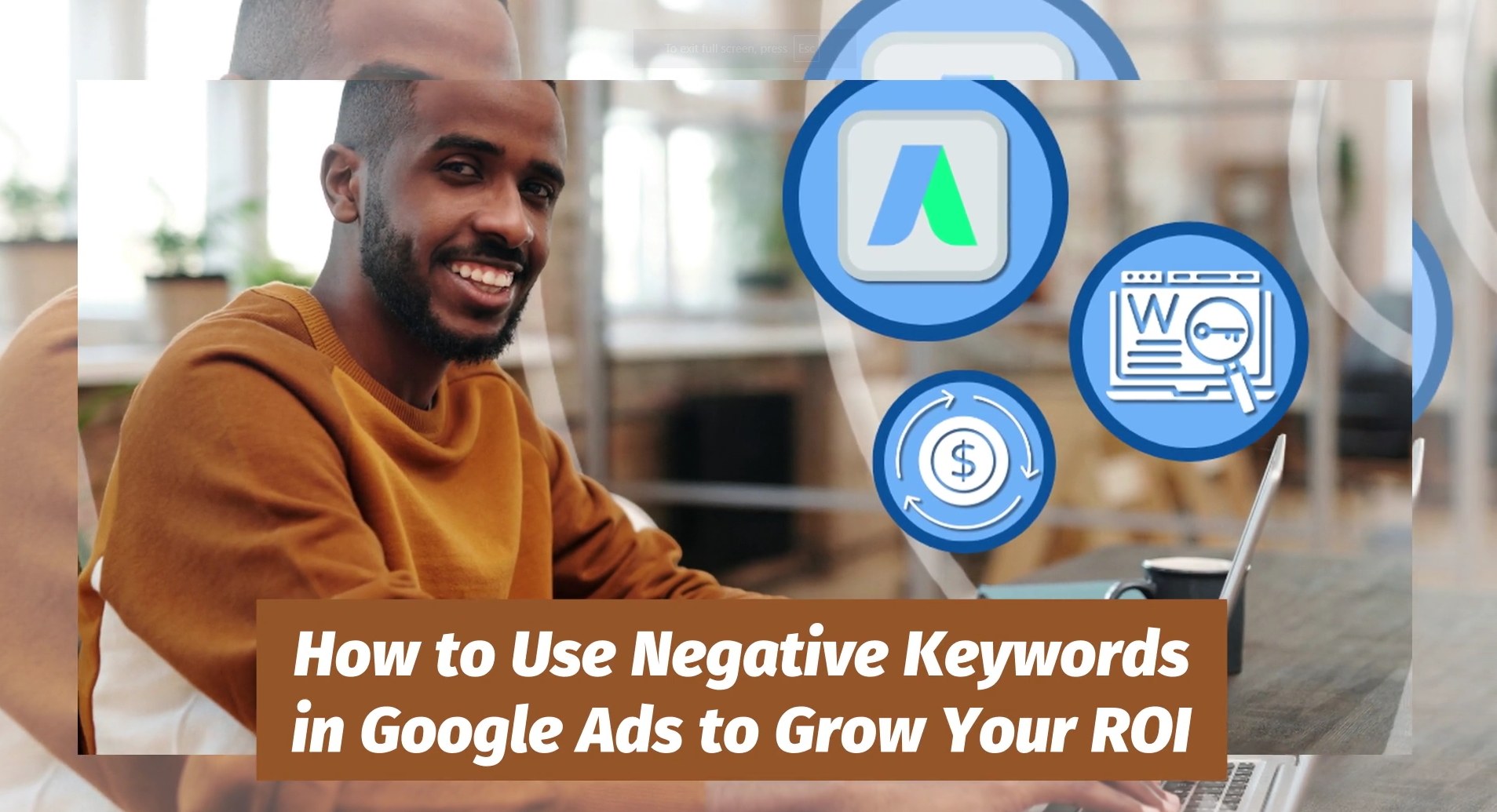Have you ever felt like your Google Ads budget is slipping through your fingers, spent on clicks that don't convert? 🤔
You're not alone.
Many advertisers face the challenge of wasted ad spend due to unoptimized keywords.
But there's a game-changing solution: negative keywords.
In this guide, we'll dive into the power of negative keywords and how they can transform your Google Ads campaigns.
By mastering negative keywords, you can:
- Refine your ad targeting
- Maximize your budget
- Boost your return on investment (ROI)!
But how do you get started?
In this post, you'll discover:
- The definition and importance of negative keywords
- Methods to identify and implement them in your campaigns
- Best practices to maintain and optimize your negative keyword lists.
By the end, you'll have the tools and knowledge you need to grow your Google Ads ROI using the power of negative keywords.
Let’s get started!...
Understanding Negative Keywords
Negative keywords are terms or phrases that prevent your ads from being displayed for specific search queries.
This ensures your ads reach the most relevant audience, leading to higher click-through rates (CTR) and better conversion rates.
But how exactly do they work?
Imagine running an ad for premium software and getting clicks from users searching for free downloads – that’s a waste of your budget.
Negative keywords help avoid this by filtering out searches that are unlikely to convert, saving your budget for clicks that matter.
This precision targeting means your ads are shown to users who are more likely to be interested in your product or service, improving the overall effectiveness of your campaign.
Negative keywords prevent your ads from showing for irrelevant searches, ensuring your budget targets only potential customersClick To Post OnThe Importance of Negative Keywords in Google Ads
- Cost efficiency—by filtering out irrelevant searches, negative keywords ensure you’re not paying for clicks that won’t convert, thus making your ad spend more efficient.
- Improved relevance—they help improve the relevance of your ads by ensuring they are shown only to users whose searches are closely aligned with your offerings.
- Enhanced performance—ads that reach a more targeted audience tend to perform better, resulting in higher CTR and conversion rates.
Types of Negative Keywords
Google Ads offers three types of negative keyword matches: broad match, phrase match, and exact match.
1. Broad Match Negative Keywords
Broad match negative keywords exclude searches that contain your negative keyword in any order.
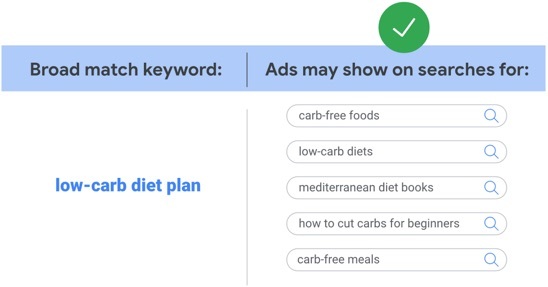
Source: Google
This match type ensures your ads are not shown for any searches that include the negative keyword, regardless of how the words are ordered.
Example: If you use "free" as a broad match negative keyword, your ad won’t appear for searches such as "free software," "software free trial," "get free software," or "best free software download."
Benefits
- Relevance filtering—improves ad relevance by filtering out irrelevant searches.
- User intent matching—ensures ads are shown to users with relevant search intent.
- Cost efficiency—avoids paying for non-converting clicks, thus improving ROI.
2. Phrase Match Negative Keywords
Phrase match negative keywords exclude searches containing the exact phrase of your negative keyword. This match type ensures your ad will not be displayed for searches that include the specific sequence of words you want to avoid.
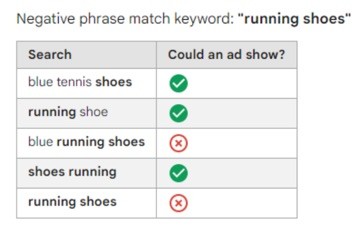
Source: Google
Example: If you use "running shoes" as a phrase match negative keyword, your ad won’t appear for searches like "blue running shoes" or "running shoes for kids."
3. Exact Match Negative Keywords
Exact match negative keywords exclude searches containing the exact keyword without any other terms. This match type prevents your ad from appearing for particular, isolated search queries.

Source: Google
Example: If you use "running shoes" as an exact match negative keyword, your ad will not appear for searches that include only this exact keyword without any other terms, such as "running shoes."
Using the right type of negative keywords helps ensure your ads are shown to the right audience, improving your campaign's overall performance and efficiency. In the next section, we’ll explore how to identify and implement negative keywords in your campaigns to maximize their effectiveness.
How To Find Negative Keywords for Your Campaigns
To maximize the effectiveness of your Google Ads campaigns, identifying and implementing the right negative keywords is crucial. Here’s a step-by-step guide to help you find and leverage these keywords for better campaign performance.
Keyword Research Tools
Start with keyword research tools to uncover potential negative keywords.
Tools like Google Ads Keyword Planner, SEMrush, and Ahrefs are excellent resources for this task.
- Google Ads Keyword Planner—this tool helps you identify search terms that people use to find products or services similar to yours. By analyzing these terms, you can identify irrelevant keywords that might trigger your ads, ensuring your ads only reach potential customers who are likely to convert.
- SEMrush and Ahrefs—both tools provide comprehensive keyword data, allowing you to filter out terms that are not relevant to your business. They also offer competitive analysis features that can reveal which keywords your competitors are avoiding.
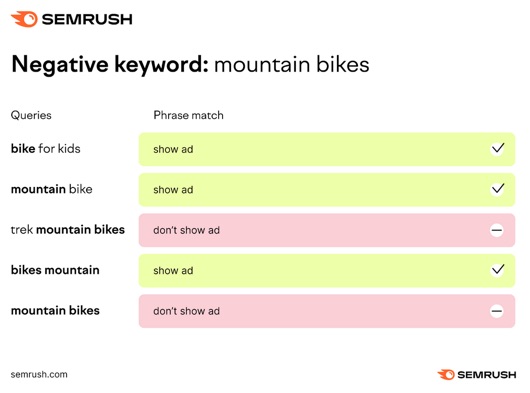
Source: SEMRUSH
Analyzing Search Terms Reports
Regularly review the Search Terms Report in Google Ads to see which search queries trigger your ads.
This report is a goldmine for identifying irrelevant keywords that waste your budget.
Regularly analyzing search term reports helps identify irrelevant queries to add as negative keywordsClick To Post OnStep-by-Step Guide
- Access the Search Terms Report—navigate to your Google Ads account and select the campaign you want to analyze. Go to the Keywords tab and click on Search Terms.
- Identify irrelevant terms—look for search queries that are not relevant to your products or services. For example, if you notice searches like "free software download" frequently trigger your ads, consider adding "free" and "download" as negative keywords.
- Add negative keywords—once you've identified irrelevant terms, add them to your negative keyword list to prevent your ads from being triggered by these searches in the future.
Competitor Analysis
Analyzing your competitors’ keyword strategies can provide valuable insights into potential negative keywords.
Tools for Competitor Analysis
- SpyFu—this tool allows you to see the keywords your competitors are using and avoiding. By understanding their strategies, you can identify additional negative keywords for your campaigns.
- SEMrush—in addition to keyword research, SEMrush offers features that reveal your competitors' advertising strategies, including the negative keywords they might be using.
Steps to Analyze Competitors
- Identify competitors—list your main competitors in the market.
- Use SpyFu or SEMrush—enter your competitors' URLs into these tools to get a list of their keywords.
- Analyze and Implement—look at the keywords they avoid and consider adding these to your negative keyword list if they are irrelevant to your business.
Best Practices for Finding Negative Keywords
- Be thorough—regularly review and update your negative keyword list. New trends and changes in search behavior can make previously relevant keywords irrelevant.
- Use specific matches—be precise with your negative keywords to avoid over-filtering. Instead of using broad terms, consider using phrase or exact match to ensure only irrelevant traffic is filtered out.
- Continuously monitor—regularly check your Search Terms Report and competitor strategies. This ongoing review process helps you refine your keyword strategy and make data-driven decisions to improve campaign performance.
By using these methods and tools, you can effectively find and implement negative keywords, ensuring your Google Ads campaigns reach the most relevant audience.
This strategic approach helps in maximizing your ad spend efficiency and improving your overall campaign performance.
Implementing Negative Keywords In Your Campaigns
Now that you understand the importance of negative keywords and how to find them, it's time to implement them in your Google Ads campaigns.
Proper implementation is key to ensuring your ads are shown to the most relevant audience, saving your budget, and maximizing your ROI.
Here's a step-by-step guide to help you set up and manage negative keywords effectively.
Setting Up Negative Keywords
Adding negative keywords to your campaigns is a straightforward process.
Here’s how to do it:
- Navigate to the Keywords tab—log in to your Google Ads account and go to the Keywords tab.
- Access the Negative Keywords section—in the left-hand panel, select Negative Keywords.
- Add Negative Keywords—click the plus button (+) to add new negative keywords. You can add these at the campaign level or the ad group level, depending on how broadly you want to apply them.
Campaign level—adding negative keywords at the campaign level ensures that these terms are excluded from all ad groups within the campaign.
Ad group level—adding negative keywords at the ad group level provides more granular control, allowing you to exclude terms from specific ad groups without affecting the entire campaign.
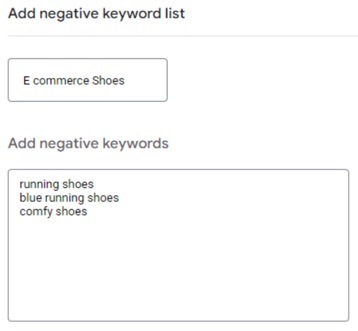
- Save and Apply—after entering your negative keywords, click Save. These keywords are now active and will prevent your ads from being triggered by irrelevant search queries.
Best Practices for List Management
Managing your negative keyword lists is an ongoing task that requires regular updates and reviews.
Here are some best practices to ensure your lists remain effective over time:
Create Comprehensive Lists
Start by creating a detailed list of negative keywords based on your research. Include terms that are irrelevant to your business to ensure your ads are not shown for non-converting searches.
Use Shared Lists
If you manage multiple campaigns, consider using shared negative keyword lists. This method ensures consistency across campaigns and simplifies the process of adding and updating negative keywords.
Benefits of Shared Lists
- Efficiency—saves time by allowing you to manage negative keywords in one place.
- Consistency—ensures all campaigns are aligned and no irrelevant keywords are missed.
Regularly Update Your Lists
As market trends and user behavior evolve, so should your negative keyword lists. Regularly review your Search Terms Report to identify new irrelevant keywords and add them to your lists.
Avoid Over-Filtering
Be specific with your negative keywords to avoid over-filtering. Using broad terms can restrict your ad reach too much, excluding potential customers. Instead, use phrase or exact match negative keywords to precisely filter out irrelevant traffic.
Example: Instead of broadly excluding the term "free," use "free software" as a phrase match to ensure you're not excluding relevant queries that might still be valuable.
Common Mistakes to Avoid
Implementing negative keywords correctly can significantly improve your campaign performance, but there are common pitfalls to avoid:
- Over-filtering—as mentioned, being too broad with negative keywords can limit your ad reach. Ensure you are specific to avoid excluding relevant traffic.
- Neglecting regular updates—failing to regularly update your negative keyword lists can result in your ads being triggered by new irrelevant search queries. Make it a habit to review and update your lists frequently.
- Ignoring Search Terms Reports—the Search Terms Report is a valuable tool for identifying ineffective keywords. Neglecting to use this report can lead to missed opportunities for optimization.
By properly implementing and managing negative keywords, you can ensure your Google Ads campaigns are more targeted and efficient.
Regularly update your negative keyword lists, use shared lists for consistency, and be mindful of not over-filtering to maintain a healthy ad reach.
This strategic approach will help you maximize your budget and see better returns on your investment.
In the next section, we'll discuss how to continuously optimize your campaigns using negative keywords, ensuring your ads remain effective and relevant over time.
Avoid adding too many negative keywords, as it may restrict your ad reach more than intendedClick To Post OnOptimizing Campaigns with Negative Keywords
Implementing negative keywords is just the beginning.
To truly maximize your Google Ads campaigns, you need to continuously optimize and refine your negative keyword strategy.
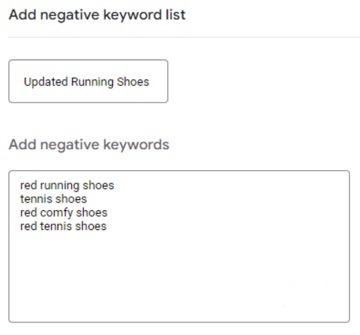
This ongoing process ensures your ads stay relevant, cost-effective, and high-performing.
Here’s how to optimize your campaigns using negative keywords.
Routine Maintenance
Regular maintenance of your negative keyword lists is crucial for keeping your campaigns effective. Set a schedule to review and update these lists at least once a month.
- Review Search Terms Reports—frequently check the Search Terms Report in Google Ads to identify new irrelevant queries that trigger your ads. Add these terms to your negative keyword list to prevent future wastage.
- Analyze performance metrics—look at key metrics such as CTR, CPC, and conversion rates. If you notice a decline in performance, investigate whether irrelevant keywords are slipping through and adjust your lists accordingly.
Impact on Campaign Performance
Using negative keywords effectively can have a significant positive impact on your campaign performance.
- Improved CTR—by filtering out irrelevant searches, your ads are shown to a more targeted audience, leading to higher click-through rates.
- Lower CPC—with fewer irrelevant clicks, your cost-per-click decreases, making your ad spend more efficient.
- Higher ROI—ultimately, more relevant traffic means higher conversion rates, leading to a better return on investment.
An example would be a WordStream case study that showed that adding negative keywords resulted in a 10% increase in CTR and a 15% decrease in CPC for one client.
Such improvements mean your ads perform better, attracting more interested users at a lower cost.
Advanced Strategies
Once you’ve mastered the basics, consider implementing advanced strategies to further optimize your campaigns.
- Geographic targeting—use negative keywords to refine geographic targeting. For example, if you’re running a local campaign, exclude terms related to other locations to ensure your ads are only shown to users in your target area.
- Funnel traffic more effectively—use negative keywords to direct traffic to the most appropriate ad groups. If you have multiple ad groups for different products, negative keywords can prevent overlap and ensure each ad group targets its specific audience. Example: If one ad group targets "software for businesses" and another targets "software for personal use," use negative keywords to exclude business-related terms from the personal use ad group and vice versa.
- Seasonal adjustments—update your negative keyword lists based on seasonal trends. For instance, if you sell holiday-related products, adjust your keywords to exclude non-seasonal terms during peak seasons.

Continuous Improvement
To maintain optimal performance, you need to stay proactive and adaptive. Here are some tips for continuous improvement:
- Set regular review sessions—schedule monthly or quarterly sessions to review and update your negative keyword lists. This helps you stay on top of changes in user behavior and market trends.
- Stay informed—keep up with industry news and best practices. Join forums, attend webinars, and read articles about Google Ads to learn new techniques and strategies.
- Experiment and test—don’t be afraid to experiment with different negative keyword strategies. Test various approaches and measure their impact on your campaign performance. Use A/B testing to see what works best for your business.
By continuously refining your keyword strategy, you can improve the performance of your ads and maximize your budget efficiency.
Negative keywords are not a one-time fix but an integral part of an ongoing optimization process that helps you stay competitive and achieve your advertising goals.
Frequently Asked Questions
What are negative keywords in Google Ads?
Negative keywords are terms or phrases that prevent your ads from showing for specific search queries, ensuring your budget targets only potential customers.
How can I find negative keywords for my campaigns?
Use keyword research tools like Google Ads Keyword Planner, SEMrush, and Ahrefs to uncover irrelevant terms, analyze Search Terms Reports, and conduct competitor analysis.
How do I implement negative keywords in Google Ads?
Navigate to the Keywords tab in Google Ads, access the Negative Keywords section, add terms at the campaign or ad group level, and regularly update and manage your lists for better performance.
Why are negative keywords important for Google Ads campaigns?
Negative keywords enhance cost efficiency, improve ad relevance, and boost performance by ensuring ads reach a more targeted audience, leading to higher CTR and conversion rates.
What are the best practices for managing negative keyword lists?
Create comprehensive lists, consider using shared lists for consistency, regularly update to avoid over-filtering, and monitor Search Terms Reports and competitor strategies for optimization.
To Conclude
Negative keywords are a powerful tool for optimizing Google Ads campaigns.
By regularly updating and managing your negative keyword lists, you can ensure your ads reach the right audience, boost your campaign effectiveness, and maximize your ROI.
Stay proactive, keep learning, and continuously improve your strategy to maintain a competitive edge and achieve optimal campaign performance.
